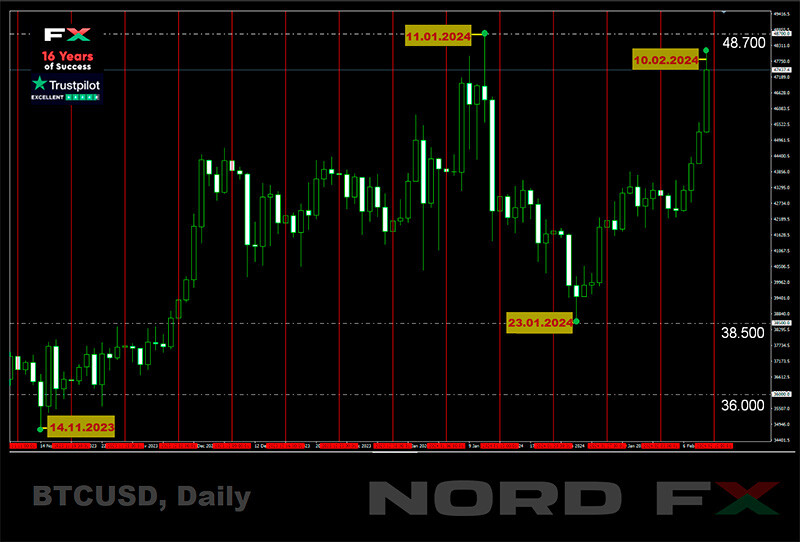Stan NordFX
Member
Forex and Cryptocurrencies Forecast for January 22 – 26, 2024
EUR/USD: Reasons Behind the Dollar's Strengthening

The past week was notably sparse in terms of macroeconomic statistics. Consequently, the market participants' sentiment largely depended on the statements made at the World Economic Forum in Davos (WEF). It's worth noting that this event, held annually at a ski resort in Switzerland, gathers representatives of the global elite from over 120 countries. There, amidst the sparkling, crystal-clear snow glistening in the sunlight, the world's power players discuss economic issues and international politics. This year, the 54th edition of the forum took place from January 15 to 19.
Speaking at the World Economic Forum on January 16, the President of the European Central Bank, Christine Lagarde, expressed her confidence that inflation would reach the target level of 2.0%. This statement did not raise any doubts, as the Consumer Price Index (CPI) in the Eurozone shows a steady decline. From a level of 10.6% at the end of 2022, the CPI has now fallen to 2.9%. Isabel Schnabel, a member of the ECB's Executive Board, did not rule out the possibility of a soft landing for the European economy and a return to the target inflation level by the end of 2024.
According to a Reuters survey of leading economists on the future monetary policy of the ECB, the majority expect the regulator to lower interest rates as early as the second quarter, with 45% of respondents believing that this decision will be made at the June meeting.
On the other hand, inflation in the United States has been unable to surpass the 3.0% mark since July 2023. The figures published on January 11th showed that the annual Consumer Price Index (CPI) increased by 3.4%, which was above the consensus forecast of 3.2% and the previous value of 3.1%. In monthly terms, consumer inflation also rose, registering at 0.3% against a forecast of 0.2% and a previous value of 0.1%.
In light of this, and considering that the U.S. economy appears quite stable, the likelihood of the Federal Reserve lowering interest rates in March started to diminish. This shift in sentiment led to a slight strengthening of the dollar, moving EUR/USD from the 1.0900-1.1000 range to the 1.0845-1.0900 zone. Additionally, the weak performance of the Asian stock markets exerted some pressure on the European currency.
According to economists at the Dutch Rabobank, long positions on the euro may face further challenges. This could happen if Donald Trump continues his movement towards a potential second term in the White House. "Although President Biden's Inflation Reduction Act meant that the past four years were not always easy for Europe, Trump's stance on NATO, Ukraine, and possibly climate change could prove costly for Europe and enhance the appeal of the U.S. dollar as a safe asset," the Rabobank experts write. "Based on this, we see a possibility of EUR/USD falling to 1.0500 in a three-month perspective."
EUR/USD closed last week at 1.0897. Currently, the majority of experts predict a rise in the U.S. dollar in the near future. 60% voted in favour of the dollar's strengthening, 20% sided with the euro, and the remaining 20% took a neutral stance. Oscillator readings on the D1 chart confirm the analysts' forecast: 80% are coloured red, indicating a bearish trend, and 20% are in neutral grey. Among the trend indicators, there is a 50/50 split between red (bearish) and green (bullish) signals.
The nearest support levels for the pair are located in the zones of 1.0845-1.0865, followed by 1.0725-1.0740, 1.0620-1.0640, 1.0500-1.0515, and 1.0450. On the upside, the bulls will face resistance at 1.0905-1.0925, 1.0985-1.1015, 1.1110-1.1140, 1.1230-1.1275, 1.1350, and 1.1475.
Unlike the past week, the upcoming week promises to be more eventful. On Tuesday, January 23, we will see the publication of the Eurozone Bank Lending Survey. Wednesday, January 24, will bring a deluge of preliminary statistics on business activity (PPI) in various sectors of the German, Eurozone, and U.S. economies. The main event on Thursday, January 25, will undoubtedly be the European Central Bank's meeting, where a decision on the interest rate will be made. It is expected to remain at the current level of 4.50%. Investors will therefore be paying close attention to what the ECB leaders say at the subsequent press conference. For reference, the FOMC meeting of the Federal Reserve is scheduled for January 31. Additionally, on January 25, we will learn about the GDP and unemployment data in the United States, and the following day, data on personal consumption expenditures of residents of this country will be released.
GBP/USD: High Inflation Leads to High Rates and a Stronger Pound
Unlike the United States and the Eurozone, there was a significant amount of important statistics released last week concerning the state of the British economy. On Wednesday, January 17, traders were focused on the December inflation data. The data revealed that the Consumer Price Index (CPI) in the United Kingdom rose from -0.2% to 0.4% month-on-month (against a consensus forecast of 0.2%) and reached 4.0% year-on-year (compared to the previous value of 3.9% and expectations of 3.8%). The core CPI remained at the previous level of 5.1% year-on-year.
Following the release of the report showing inflation growth, UK Prime Minister Rishi Sunak moved quickly to reassure the markets. He stated that the government's economic plan remains correct and continues to work, having reduced inflation from 11% to 4%. Sunak also noted that wages in the country have been growing faster than prices for five months, suggesting that the trend of weakening inflationary pressure will continue.
Despite this optimistic statement, many market participants believe that the Bank of England (BoE) will postpone the start of easing its monetary policy until the end of the year. "Concerns that the disinflation process might slow down have likely intensified as a result of the latest inflation data," economists at Commerzbank write. "The market will probably bet on the Bank of England responding accordingly and, therefore, being more cautious regarding the first interest rate cut."
Clearly, if the BoE does not rush to ease monetary policy, this will create ideal conditions for the long-term strengthening of the British pound. This prospect already allowed the GBP/USD pair to bounce off the lower boundary of its five-week channel at 1.2596 on January 17th, rising to the channel's midpoint at 1.2714.
It is quite possible that GBP/USD would have continued its upward trajectory, but it was hindered by weak retail sales data in the United Kingdom, which were published at the end of the workweek on Friday, January 19th. The data showed a decline in this indicator by 4.6%, from +1.4% in November to -3.2% in December (against a forecast of -0.5%). If the upcoming Purchasing Managers' Indexes and business activity indicators, due to be released on January 24th, paint a similar picture, it could exert even more pressure on the pound. The Bank of England might fear that a stringent monetary policy could overly decelerate the economy and might consider easing it. According to analysts at ING (Internationale Nederlanden Groep), a reduction in the key interest rate by 100 basis points could lead to GBP/USD falling to the 1.2300 zone over a one to three-month horizon.
ING analysts also believe that the UK budget announcement on March 6 will significantly impact the pound, with tax cuts on the agenda. "Unlike in September 2022," the experts write, "we believe this will be a real tax cut, financed by the reduced cost of debt servicing. This could add 0.2-0.3% to the UK's GDP this year and lead to the Bank of England maintaining higher rates for a longer period."
GBP/USD ended the last week at 1.2703. Looking ahead to the coming days, 65% voted for the pair's decline, 25% were in favour of its rise, and 10% preferred to remain neutral. Contrary to the specialists' opinions, the trend indicators on D1 show a preference for the British currency: 75% indicate a rise in the pair, while 25% point to a decline. Among the oscillators, 25% are in favor of the pound, the same proportion (25%) for the dollar, and 50% hold a neutral position. If the pair moves southward, it will encounter support levels and zones at 1.2650, 1.2595-1.2610, 1.2500-1.2515, 1.2450, 1.2330, 1.2210, 1.2070-1.2085. In case of an upward movement, the pair will meet resistance at 1.2720, 1.2785-1.2820, 1.2940, 1.3000, and 1.3140-1.3150.
No significant events related to the United Kingdom's economy are anticipated for the upcoming week, other than the previously mentioned events. The Bank of England's next meeting is scheduled for Thursday, February 1.
continued below...











